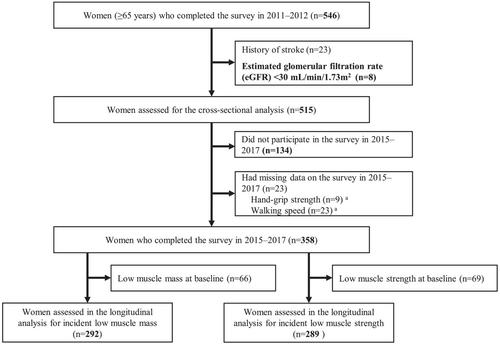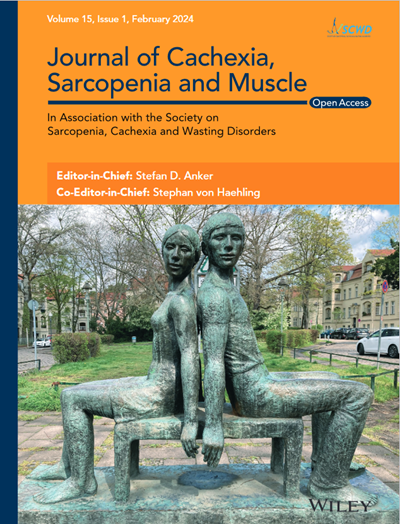Association between the 110-kDa C-terminal agrin fragment and skeletal muscle decline among community-dwelling older women
Abstract
Background
C-terminal agrin fragment (CAF) is a biomarker for neuromuscular junction degradation. This study aimed to investigate whether 110-kDa CAF (CAF110) was associated with the presence and incidence of low muscle mass and strength.
Methods
This cross-sectional retrospective cohort study comprised women aged ≥65 years. We measured muscle mass using a dual-energy X-ray absorptiometry scanner, hand-grip strength, and blood sampling between 2011 and 2012. A follow-up study with the same measurements was conducted between 2015 and 2017. Low muscle mass and strength were defined as an appendicular skeletal muscle mass index <5.4 kg/m2 and hand-grip strength <18 kg, respectively. The CAF110 level was measured using enzyme-linked immunosorbent assay kits.
Results
In total, 515 women (74.3 ± 6.3 years) were included in this cross-sectional analysis. Of these, 101 (19.6%) and 128 (24.9%) women presented with low muscle mass and strength, respectively. For low muscle mass, the odds ratios (ORs) of the middle and highest CAF110 tertile groups, compared with the lowest group, were 1.93 (95% confidence interval: 1.09–3.43; P = 0.024) and 2.15 (1.22–3.80; P = 0.008), respectively. After adjusting for age, the ORs remained significant: 1.98 (1.11–3.52; P = 0.020) and 2.27 (1.28–4.03; P = 0.005), respectively. Low muscle strength ORs of all the CAF110 tertile groups were not significant. In the longitudinal analysis, 292 and 289 women were assessed for incidents of low muscle mass and strength, respectively. Of those, 34 (11.6%) and 20 (6.9%) women exhibited low muscle mass and strength, respectively. For incident low muscle mass, the crude OR of the CAF110 ≥ the median value group was marginally higher than that of the CAF110 < median value group (median [interquartile range]: 1.98 [0.94–4.17] (P = 0.072). After adjusting for age and baseline muscle mass, the OR was 2.22 [0.97–5.06] (P = 0.058). All low muscle strength ORs of the median categories of CAF110 were not significant.
Conclusions
CAF110 was not associated with low muscle strength. However, CAF110 may be a potential marker for the incidence of low muscle mass.


 求助内容:
求助内容: 应助结果提醒方式:
应助结果提醒方式:


